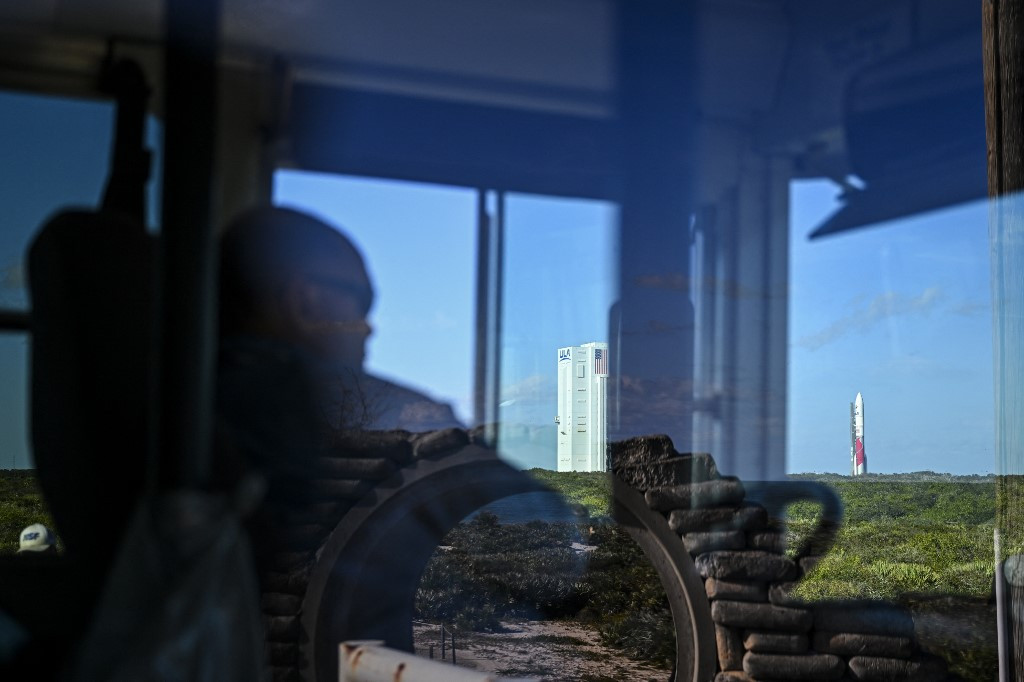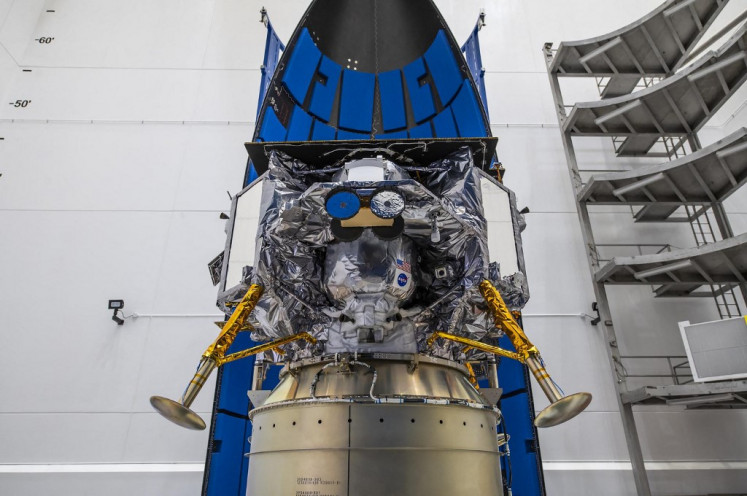Popular Reads
Top Results
Can't find what you're looking for?
View all search resultsPopular Reads
Top Results
Can't find what you're looking for?
View all search resultsRocket carrying American lunar lander arrives at launchpad
United Launch Alliance' Vulcan Centaur rocket rolled out in the morning to its launchpad at Cape Canaveral Space Force Station, preparing for its maiden flight to blast off on Monday at 2:18 am local time.
Change text size
Gift Premium Articles
to Anyone
 ULA's new rocket Vulcan Centaur carrying Peregrine lunar lander rolls to Space Launch Complex 41 (right) at NASA's Kennedy Space Center in Cape Canaveral, Florida, on Jan. 5, 2024. The new ULA is to make its maiden flight on Jan. 8, 2024, with a payload that includes a private lunar lander. (AFP/Chandan Khanna)
ULA's new rocket Vulcan Centaur carrying Peregrine lunar lander rolls to Space Launch Complex 41 (right) at NASA's Kennedy Space Center in Cape Canaveral, Florida, on Jan. 5, 2024. The new ULA is to make its maiden flight on Jan. 8, 2024, with a payload that includes a private lunar lander. (AFP/Chandan Khanna)
F
inal preparations were underway Friday for the launch of the first American spacecraft to attempt a lunar landing in more than 50 years, under a new partnership between NASA and private industry.
United Launch Alliance' Vulcan Centaur rocket rolled out in the morning to its launchpad at Cape Canaveral Space Force Station, preparing for its maiden flight to blast off on Monday at 2:18 am local time (7:18 a.m. GMT).
Fixed to its top is the Peregrine Lunar Lander, built by Pittsburgh-based Astrobotic, which should touch down at a mid-latitude region of the Moon called Sinus Viscositatis, or Bay of Stickiness, in mid-February.
The 62-meter-tall red and white Vulcan Centaur is the successor to ULA's Atlas V and Delta IV launchers, and the company hopes to soon start reusing its first stage booster engines in order to make significant cost savings.
"Now that is a beautiful sight," tweeted ULA CEO Tory Bruno after its arrival at Launch Complex 41 on a giant ground transporter.
If the mission is successful, it would mark the first time an American robot "soft" lands on the Moon since the Apollo 17 mission in 1972, and the first under NASA's Commercial Lunar Payload Services (CLPS) program.
The space agency has paid Astrobotic and another company planning an imminent mission, Intuitive Machines, just shy of $80 million to ship its scientific hardware.
This image released by NASA shows Astrobotic's Peregrine lunar lander being encapsulated in the payload fairing, or nose cone, of United Launch Alliance's Vulcan rocket on Nov. 21, 2023, at Astrotech Space Operations Facility near the agency's Kennedy Space Center in Florida. (AFP/NASA)It would also be the first time the private sector succeeds in a feat few countries have achieved: the Soviet Union was first in 1966, then the United States, and since then China and India. Japan and Israel's recent attempts failed, as has Russia's.
"This whole task is not easy; landing on the moon is extremely difficult," Chris Culbert, CLPS program manager said. "The surface of the Moon holds many robotic spacecraft that were not able to land softly and complete their mission."
Making matters more fraught is the fact it is the first launch for ULA's Vulcan, though the company boasts of a 100 percent success rate in its more than 150 prior launches.
On board Peregrine are a suite of scientific instruments that will probe the lunar environment, helping to pave the way for the return of astronauts under the banner of the NASA-led Artemis program, later this decade.
But it also contains more colorful cargo, including a physical bitcoin, sculptures by the artist Jeff Koons, and, somewhat controversially, DNA and human remains, including those of Star Trek creator Gene Roddenberry and the legendary sci-fi author and scientist Arthur C. Clarke.
The Navajo Nation, America's largest Indigenous tribe, have said sending remains to the Moon desecrates the celestial body and have unsuccessfully pleaded for a delay, while the companies involved have rejected the accusation.
The Vulcan rocket's upper stage, which will circle the Sun after it deploys the lander, is meanwhile carrying more late cast members of Star Trek, as well as DNA from presidents George Washington, Dwight D Eisenhower and John F Kennedy.











